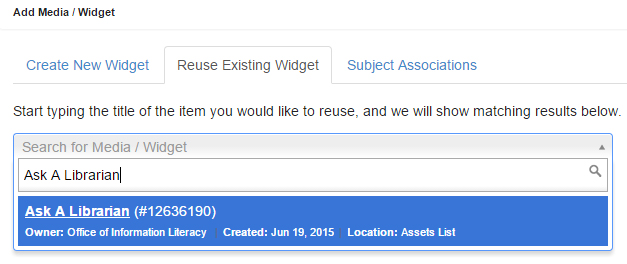Reuse it!
Almost everything in the LibGuides system is reusable - guides, pages, boxes, and individual content items. It will save time and effort when creating your guides by reusing existing content. There are two kinds of reuse:
- Mapping / linking: this means that your reused versions are tied to the original. Changes you make to the original will update any "mapped" version. This is great for things like library hours, contact information, database widgets, etc.
- Copying: the copied version is independent from the original. If you change one, it doesn't change the other.
| Map | Copy | |
|---|---|---|
| Guides | NO | YES |
| Pages | YES | YES |
| Boxes | YES | YES |
| Databases | YES | NO |
| Other Content Items (Widgets, Books, etc.) |
YES | YES |
Implications/Instructions
Consider Setting Up a "Storage Guide" or "Blueprint Guide"
- A Storage Guide is simply a place for you to put pages & boxes that you can reuse it again in different guides. A few suggestions on things you can keep in your storage guide:
- Library hours and contact information
- Instructions (ex. how to access databases off-campus)
- A Blueprint Guide serves as a pattern or plan to create other guides. The consistency provided by blueprint guides means that your guides are more alike - making it easier for your users to focus on the content, and not the structure.
Create Once, Edit Once: Avoid Duplicate Assets
When reusing content, keep in mind that Mapping/Linking is better than Copying because it's easier to maintain consistency and currency of your guide content. It is suggested that you:
- Go to the Assets library (Content>Assets) to review and manage content assets in all of your guides, including: links, RSS feeds, documents, books, media/widget...etc.
- Deduplicate Assets: Type your name in the Owner column to sort and find all the assets owned (created) by you. If you found duplicate assets:
- Find the duplicate(s) and click on the number in the Guide Count column.
- Click on the guide title to go to the guide.
- Remove the duplicate asset from the guide.
- Add the correct asset by reusing the existing links or other asset to the guide.
- Go back to the assets page and repeat this process until the Guide Count of the duplicate asset(s) is at 0.
- Delete the duplicate asset(s) from the assets page.
Assets to Reuse
A set of centrally managed assets have been created and are located in the Asset library. When creating new guides, users should map to these assets instead of creating new links or widgets on each individual guide. If any changes need to be made to the assets, this can be done centrally and without any interruption to guide use. These assets are:
- Databases: We have worked with the eResources team and created the library A-Z databases list in LibGuides. To access the list, click on “Go to A-Z List” from LibGuides homepage. You are encouraged to reuse the database links in the LibGuides system whenever you wish to refer to databases in your guides.
To reuse the database links, you will:- In the edit mode, click "Add/Reorder" button and then select database.
- Click Search for database and then start typing in the database title.
- Select the database, and then put in your custom description if you don't want to show the default description.
- Select where you want to insert the database links (position), and then click "Save."
- Ask A Librarian chat widget: add a chat widget to your guide.
 To reuse Ask A Librarian chat widget, you will:
To reuse Ask A Librarian chat widget, you will:
- In the edit mode, click "Add/Reorder" button and then select Media / Widget.
- Choose the Reuse Existing Widget tab and then type "Ask a Librarian" in the search box.
- Select the widget, and then select where you want to insert the widget (position).
- Click "Save" when done.
- Easy Search widget: Follow the general reuse widget instructions to add it. Also refer to the Easy Search for LibGuides guide for detailed instructions on how to reuse Easy Search widget in LibGuides.
 To reuse Ask A Librarian chat widget, you will:
To reuse Ask A Librarian chat widget, you will: